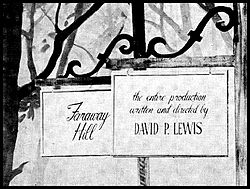Faraway Hill (lost early soap opera; 1946): Difference between revisions
mNo edit summary |
No edit summary |
||
| (One intermediate revision by the same user not shown) | |||
| Line 17: | Line 17: | ||
In 1992, the show's producer and writer, David P. Lewis, passed away. In the LA Times obituary for Lewis, it mentioned ''Faraway Hill'' and said: | In 1992, the show's producer and writer, David P. Lewis, passed away. In the LA Times obituary for Lewis, it mentioned ''Faraway Hill'' and said: | ||
<blockquote> Lewis declared at the time that it was only an experiment. It never made a cent and had no commercials. ... He wanted, he said years later, not a successful series but to 'test the mind of the viewer.' </blockquote> | <blockquote> Lewis declared at the time that it was only an experiment. It never made a cent and had no commercials. ... He wanted, he said years later, not a successful series but to 'test the mind of the viewer.'<ref>[https://web.archive.org/web/20170820025001/http://articles.latimes.com/1992-10-30/news/mn-697_1_soap-opera The obituary for David P. Lewis.] Retrieved 22 Oct '19</ref></blockquote> | ||
==Availability== | ==Availability== | ||
As mentioned before, the | As mentioned before, the series was broadcast live, which means no recordings were ever made. Recording television was hard around this time, as kinescopes did not exist until 1947. Also as stated above, the series did have filmed segments, but they have not surfaced to this day. ''Faraway Hill'' was also a part of DuMont, the network that took itself off the airwaves in 1956,<ref>[http://archive.is/dNal A webpage on the closing of the DuMont Network.] Retrieved 11 Feb '19</ref> and destroyed many of their TV shows, likely including filmed parts of ''Faraway Hill''. If the revelation that the series was included in the destruction is true, then ''Faraway Hill'' may be lost for good. The only visual evidence of the show left is a title card. | ||
==External Links== | ==External Links== | ||
| Line 30: | Line 30: | ||
[[Category:Lost TV]] | [[Category:Lost TV]] | ||
[[Category:Completely lost media]] | |||
[[Category:Historic]] | [[Category:Historic]] | ||
Revision as of 02:08, 7 May 2020
Faraway Hill was a soap opera that premiered on October 2nd, 1946 on the DuMont Network, and ended on December 18th, 1946.[1] It was the very first soap opera broadcast on television.
Plot
The show would involve a New York City widow named Karen St. John, who would move to a small city to be near her relatives. Here, she would meet a man who had been adopted by Karen's family. She would fall in love with this man, but he would have already been engaged with another woman. Also, Karen, a sophisticated woman, would sometimes clash with her rural relatives.
Production
Episodes of the series were made on a very small budget of $300.[2] The series starred actors and actresses like Flora Campbell as the main character, Mel Brandt (not to be confused with Mel Blanc), Eve McVeagh, etc.[2]
The show was broadcast live. However, filmed parts were interspersed, and slides made of previous episodes were made to keep viewers in on what was happening in the show. An unknown announcer narrated Karen's thoughts as bridges between other scenes.[2]
In 1992, the show's producer and writer, David P. Lewis, passed away. In the LA Times obituary for Lewis, it mentioned Faraway Hill and said:
Lewis declared at the time that it was only an experiment. It never made a cent and had no commercials. ... He wanted, he said years later, not a successful series but to 'test the mind of the viewer.'[3]
Availability
As mentioned before, the series was broadcast live, which means no recordings were ever made. Recording television was hard around this time, as kinescopes did not exist until 1947. Also as stated above, the series did have filmed segments, but they have not surfaced to this day. Faraway Hill was also a part of DuMont, the network that took itself off the airwaves in 1956,[4] and destroyed many of their TV shows, likely including filmed parts of Faraway Hill. If the revelation that the series was included in the destruction is true, then Faraway Hill may be lost for good. The only visual evidence of the show left is a title card.
External Links
- IMDb page for the show. Retrieved 11 Feb '19
- Wikipedia page for the show. Retrieved 11 Feb '19
References
- ↑ A TV listing for the show, from 1946. Retrieved 11 Feb '19
- ↑ 2.0 2.1 2.2 The Complete Directory to Prime Time Network TV Shows, a 1964 book mentioning the show. Retrieved 11 Feb '19
- ↑ The obituary for David P. Lewis. Retrieved 22 Oct '19
- ↑ A webpage on the closing of the DuMont Network. Retrieved 11 Feb '19
